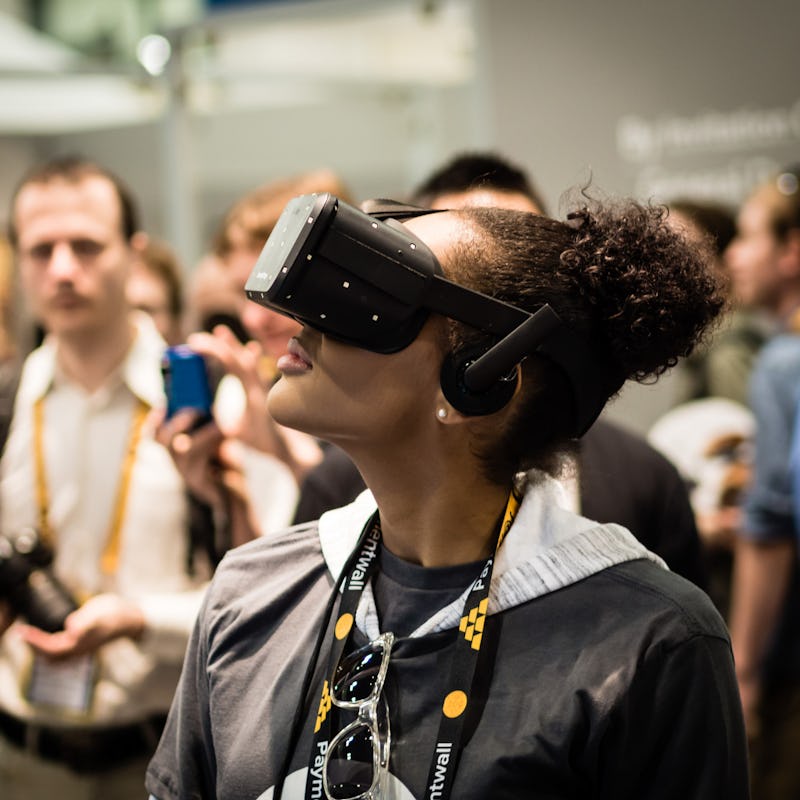True VR is Finally Coming, But What Will It Actually Look Like?
Sure, the early adopters are gamers. But VR's going to be a lot more than gaming.

We’ve been talking about it for years, but the date is finally almost here: True VR is coming to consumers. Oculus and HTC will begin shipping Rift and Vive units, respectively, to consumers in the next two weeks. The arrival of these headsets marks the very first availability of headset units to consumers outside of the developer market, and they’re the first headsets deemed ready for mainstream consumption. As we approach this ship date, the outlook on the future of VR is murkier than ever. Still, there’s some clarity surrounding where VR’s headed and what it’s going to mean.
Variety’s Janko Roettgers reports on the state of the VR market as we approach ship dates for the major headsets and discusses potential opportunities and pitfalls that come with opening up a very new technology to a consumer market for the first time.
Naturally, price is a major talking point this early in the game. There’s no getting around it: Consumer VR is expensive. The headsets themselves clock in at the $400-$800 range, which doesn’t include the price of the properly spec-d computer to run them. All told, these early VR headsets will run early adopters $1000 or more — not exactly a friendly price point for those who aren’t yet all-in on VR, and those VR fans are still relatively few and far between.
One of VR’s biggest hurdles right now is exposure. Outside of tech conferences, HTC’s Vive truck or early dev kits, opportunities for average consumers to experience immersive VR of Rift, Vive and Playstation VR caliber have been scant, and much of these early shipments will be aimed at fixing the exposure problem. The more headsets companies like Oculus and HTC have out in the wild, the more “real” VR feels to consumer. Nobody’s going to throw money at a paper tiger, so bringing headset VR into mainstream discussions is vital.
That said, no one seems to have any idea what the VR market is actually going to look like. Variety’s projections from Deloitte, CCS Insight and Digi-Capital provide a “big picture” that’s hard to pin down.
“Estimates of audience size for VR, and the revenue that Hollywood and others will generate with it, are all over the map. Deloitte Global estimates that headset manufacturers will ship 2.5 million devices by the end of this year, and that revenue from both hardware and software will total $1 billion. CCS Insight concurs with those projections, and forecasts that 24 million devices will be in the hands of consumers by 2018. Digi-Capital estimates that virtual and augmented reality will generate $150 billion by 2020.”
Beyond exposure, there lies another important objective in getting headsets into the hands of consumers: feedback.
Up until now, VR users have been largely limited to developers and very early adopters who were willing to throw money into dev kits without the intention of using it for developing purposes. As a result, creators of games and VR experiences have been flying blind when it comes to building content that mainstream users will find compelling.
So what does “content” mean in the context of VR? In short, it’s a broad term that covers two main categories — gaming and video — and a handful of developing intersections.
We���’ve known for years that the early adopter market in VR was going to be made up largely of gamers. As such, gaming is a huge part of early VR. Gaming in a VR headset happens in a number of different ways, using conventional controllers, eye-tracking mechanics and new controllers designed specifically for hand-tracking like the Oculus Touch controllers. In gaming VR experiences, users have total agency to walk around and interact with the in-headset environments. Because of the immersive nature of VR, these experiences have been very powerful, often delighting or even terrifying users.
It’s not all gaming, though, and that leads us to one of the most interesting aspects of the developing VR market: video and cinematic experiences.
Creations like Henry from Oculus and like “The Martian VR Experience” that Roettger discusses fall pretty damn far outside of the realm of what we consider to be “video content.” They bring viewers into the the film world, and that’s likely something that’s going to dictate much of what we see from VR going forward.
To go ahead and state the obvious, immersive video within headsets is a wildly different beast compared to the films and videos we watch on televisions and computers. In most cases, immersive video is all-around you, rather than right in front of you. You can turn your head, turn around, look up and look down. This creates challenges in filming, of course, but it also creates a number of opportunities in narrative and effects.
When you watch a movie, you watch what happens in front of you. When you watch something in VR, though, you have the power to look anywhere. This means that writers and directors will need to approach storytelling in VR in an entirely new way, finding ways to direct your attention as you investigate the world around you. In traditional movies, you see what the director wants you to see, but in VR you may have the power to see everything.
We don’t yet have a good handle on what VR is going to look like in our living rooms. There are experiences. There are games. There are virtual cinema apps. But as VR headsets ship out and find themselves in the hands of consumers, we’re going to learn a lot very quickly. VR’s in its infancy right now, but it’s a good bet that if any of the market projections are at all close to the mark, it won’t be for long.